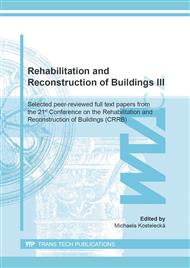[1]
V. Pavlík, M. Užáková, Effect of curing conditions on the properties of lime, lime–metakaolin and lime–zeolite mortars. Constr. Build. Mater. 102 (2016) 14-25.
DOI: 10.1016/j.conbuildmat.2015.10.128
Google Scholar
[2]
O. Cizer, Competition between Carbonation and Hydration on the Hardening of Calcium Hydroxide and Calcium Silicate Binders, (PhD thesis) Univ. KU Leuven, Belgium, (2009).
DOI: 10.1533/9780857093080.589
Google Scholar
[3]
O. Cizer, K. Van Balen, D. Van Gemert, Competition between hydration and carbonation in hydraulic lime and lime-pozzolana mortars. Advanced Mater. Res. Vol. 133-134 (2010)241-246.
DOI: 10.4028/www.scientific.net/amr.133-134.241
Google Scholar
[4]
H.J. Kuzel, H. Pollmann, Hydration of C3A in the Presence of Ca(OH)2, CaSO4·2H2O and CaCO3, Cem. Concr. Res. 21 (1991) 885-895.
DOI: 10.1016/0008-8846(91)90183-i
Google Scholar
[5]
W. Dosch, H. Keller, H. zur Strassen, Written discussion. In: Proc. 5th International Symp. Chem. Cem. Tokyo, 1969. Vol. II, pp.72-77.
Google Scholar
[6]
M. Francois, G. Renaudin, O. Evrard, A cementitious compound with composition 3CaO·Al2O3·CaCO3·11H2O, Acta Crystallographica, Section C, Crystal Structure Communications C54 (1998) 1214-1217.
DOI: 10.1002/chin.199851002
Google Scholar
[7]
R. Allmann, Refinement of the hybrid layer structure [Ca2Al(OH)6]+·[1/2SO4·3H2O]−, Neues Jahrbuch fur Mineralogie Monatshefte (1977) 136-144.
Google Scholar
[8]
R. Fischer, H.J. Kuzel, Reinvestigation of the system C4A•nH2O–C4A•CO2•nH2O, Cem. Concr. Res. 12 (1982) 517-526.
DOI: 10.1016/0008-8846(82)90066-7
Google Scholar
[9]
H.F.W. Taylor, Cement Chemistry, second ed., Thomas Telford Publishing, London, (1997).
Google Scholar
[10]
G. Renaudin, M. Francois, O. Evrard, Order and disorder in the lamellar hydrated tetracalcium monocarboaluminate compound, Cem. Concr. Res. 29 (1999) 63-69.
DOI: 10.1016/s0008-8846(98)00184-7
Google Scholar
[11]
T. Matschei, B. Lothenbach, F.P. Glasser, The AFm phase in Portland cement, Cem. Concr. Res. 37 (2007) 118–130.
DOI: 10.1016/j.cemconres.2006.10.010
Google Scholar
[12]
D. Damidot, S. Stronach, A. Kindness, M. Atkins, F.P. Glasser, Thermodynamic investigation of the CaO–Al2O3–CaCO3–H2O closed system at 25 °C and the influence of Na2O. Cem. Concr. Res. 24 (1994) 563–572.
DOI: 10.1016/0008-8846(94)90145-7
Google Scholar
[13]
T. Matschei, Thermodynamics of cement hydration, (PhD thesis), Univ. Aberdeen, (2007).
Google Scholar
[14]
G. Hentschel, H.J. Kuzel, Strätlingit, 2CaO.Al2O3.SiO2.8H2O, ein neues Mineral, Neues Jahrbuch für Mineralogie Monatshefte (1976) 326-330.
Google Scholar
[15]
S. Kwan, J. LaRosa, M.W. Grutzeck, 29Si and 27Al MASNMR study of stratlingite, J. Am. Ceram. Soc. 78 (1995) 1921–(1926).
DOI: 10.1111/j.1151-2916.1995.tb08910.x
Google Scholar
[16]
R. Dron, Experimental and theoretical study of the CaO-Al2O3-SiO2-H2O system, in: 6th International Congr. Chem. Cem., Moscow, Vol. II, Book 1, 1976, pp.208-211.
Google Scholar
[17]
D. Damidot, F.P. Glasser, Investigation of the CaO-Al2O3-SiO2-H2O system at 25°C by thermodynamic calculations, Cem. Concr. Res. 25 (1995) 22-28.
DOI: 10.1016/0008-8846(94)00108-b
Google Scholar
[18]
P.S. de Silva, F.P. Glasser, Phase relations in the system CaO-Al2O3-SiO2-H2O relevant to metakaolin - calcium hydroxide hydration, Cem. Concr. Res. 23 (1993) 627-639.
DOI: 10.1016/0008-8846(93)90014-z
Google Scholar
[19]
A. Santos-Silva, A. Gameiro, J. Grilo, R. Veiga, A. Velosa, Long-term behavior of lime–metakaolin pastes at ambient temperature and humid curing condition. Appl. Clay Sci. 88-89 (2014) 49-55.
DOI: 10.1016/j.clay.2013.12.016
Google Scholar
[20]
A.S. Silva, A. Gameiro, J. Grilo, R. Veiga, A. Velosa, Long-term behavior of lime–metakaolin pastes at ambient temperature and humid curing condition. Appl Clay Sci 88-89 (2014) 49-55.
DOI: 10.1016/j.clay.2013.12.016
Google Scholar
[21]
M.D. Andersen, H.J. Jakobsen, J. Skibsted, Incorporation of aluminum in the calcium silicate hydrate (C-S-H) of hydrated Portland cements: a high-field 27Al and 29Si MAS NMR investigation, Inorg. Chem. 42 (2003) 2280–2287.
DOI: 10.1021/ic020607b
Google Scholar
[22]
X. Pardal, I. Pochard, A. Nonat, Experimental study of Si–Al substitution in calcium-silicate-hydrate (C-S-H) prepared under equilibrium conditions, Cem. Concr. Res. 39 (2009) 637–643.
DOI: 10.1016/j.cemconres.2009.05.001
Google Scholar
[23]
E. L'Hôpital, B. Lothenbach, G. Le Saout, D. Kulik, K. Scrivener, Incorporation of aluminium in calcium-silicate-hydrates. Cem.Concre.Res. 75 (2015) 91-103.
DOI: 10.1016/j.cemconres.2015.04.007
Google Scholar
[24]
V. Pavlík, J. Bisaha, Lightweight Mortars Based on Expanded Perlite, Key Engineering Materials, 776 (2018) 104-117.
DOI: 10.4028/www.scientific.net/kem.776.104
Google Scholar


